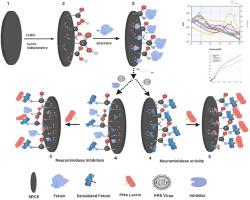Sensors and Actuators Reports ( IF 6.5 ) Pub Date : 2021-08-30 , DOI: 10.1016/j.snr.2021.100047 Anil Gattani 1, 2 , Shiv Varan Singh 3 , P. Kirthika 1, 4 , Aditya Agrawal 1 , Manish Mahawar 1 , Sadhan Bag 5 , Kaushal Kishor Rajak 6 , Raj Kumar Singh 7 , Praveen Singh 1, 8

|
Neuraminidase (NA) is a viral glycoprotein present in the surface of viruses belonging to paramyxoviridae and orthomyxoviridae. It helps in viral attachment and movement in the airways. It is also essential for release of viral progeny from the infected cells. Thus, anti-neuraminic agents have the potential to obstruct infection well before the virus interacts with the host. In the present study, we describe a label-free electrochemical impedance spectroscopy to characterise the NA inhibitors of plant origin against the Peste des petits ruminants virus NA. A decrease in charge transfer resistance, ΔRct (>50%;p<0.05) was observed for morin and eugenol when incubated against NA validates their anti-neuraminidase activity. Further, reduced virus propagation in vitro corroborated the efficient anti-neuraminic activity of morin and eugenol. PPRV Neuraminidase Inhibition stipulated the IC50 of 26.01 µM and 115.1 µM for morin and eugenol respectively. Additionally, we observed a selective index of both phytochemicals (16.2 for morin and 11.75 for eugenol). The proposed impedance spectroscopy method has sensitivity comparable to that of traditional, but avoiding the tedious screening system for anti- neuraminic compounds.
中文翻译:

胎球蛋白衍生表面用于在电化学阻抗传感器上评估小反刍兽疫病毒的神经氨酸酶抑制剂
神经氨酸酶 (NA) 是一种存在于副粘病毒科和正粘病毒科病毒表面的病毒糖蛋白。它有助于呼吸道中的病毒附着和运动。它对于从受感染细胞中释放病毒后代也是必不可少的。因此,抗神经氨酸药物有可能在病毒与宿主相互作用之前阻止感染。在本研究中,我们描述了一种无标记电化学阻抗谱,以表征植物来源的 NA 抑制剂对小反刍动物疫病病毒 NA 的抑制作用。当针对 NA 温育时,观察到桑椹和丁香酚的电荷转移电阻 ΔR ct (>50%;p<0.05)降低,验证了它们的抗神经氨酸酶活性。此外,减少病毒体外传播证实了桑椹和丁子香酚的有效抗神经氨酸活性。PPRV 神经氨酸酶抑制规定桑椹和丁子香酚的 IC 50 分别为 26.01 µM 和 115.1 µM。此外,我们观察到两种植物化学物质的选择性指数(桑椹为 16.2,丁香酚为 11.75)。所提出的阻抗谱方法具有与传统方法相当的灵敏度,但避免了繁琐的抗神经氨酸化合物筛选系统。











































 京公网安备 11010802027423号
京公网安备 11010802027423号